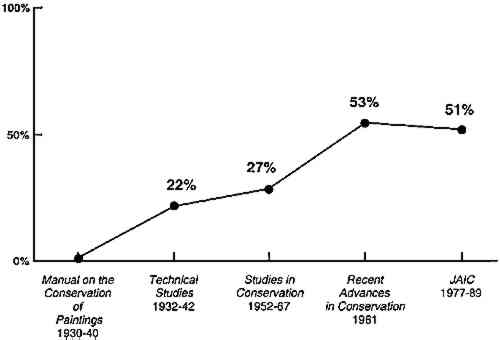THE IMPACT OF RESEARCH ON THE LINING AND CLEANING OF EASEL PAINTINGSJOYCE HILL STONER
4 RESEARCHPerhaps the two most controversial and potentially irreversible things paintings conservators do is to clean and to line paintings. Many changes have taken place in these two pursuits in the last three decades, since the 1960s. The 1960s were noted for worldwide turmoil, but the 1970s witnessed the greatest number of changes in conservation. This paper attempts to assess how much published research has affected these changes. “Research” is defined in Webster's New World Dictionary as “careful, systematic, patient study and investigation in some field of knowledge, undertaken to establish facts or principles.” If we look again at these same signpost publications, we can see a shift from articles reporting “this is how I treated this painting” to “careful, systematic ‘investigations’ to establish facts or principles” (fig. 2). The percentage of research articles has steadily increased from 0% to slightly more than 50%, but many of these articles are about pigments used by certain artists or results of instrumental analysis, which produced findings that may not actually have an impact where the swab meets the varnish or the canvas meets the adhesive.
To assess the practical impact of conservation research on the treatment of paintings, a list of researchers was drawn up based on the following criteria: (1) their research was published; (2) the research had appeared in English-language publications within the last three decades; (3) the research related to practical aspects of cleaning or lining paintings. A draft list and a questionnaire were circulated to four paintings conservation colleagues, asking for corrections or additions. Their responses produced this list: |
